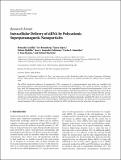| dc.contributor.author | Castillo, Betzaida | |
| dc.contributor.author | Badillo, Valerie | |
| dc.contributor.author | Hatton, T. Alan | |
| dc.contributor.author | Barletta, Gabriel | |
| dc.contributor.author | Bromberg, Lev E. | |
| dc.contributor.author | Lopez, Xaira | |
| dc.contributor.author | Gonzalez Feliciano, Jose A. | |
| dc.contributor.author | Gonzalez, Carlos I. | |
| dc.date.accessioned | 2013-06-17T13:32:33Z | |
| dc.date.available | 2013-06-17T13:32:33Z | |
| dc.date.issued | 2012 | |
| dc.date.submitted | 2012-07 | |
| dc.identifier.issn | 2090-3014 | |
| dc.identifier.issn | 2090-3022 | |
| dc.identifier.uri | http://hdl.handle.net/1721.1/79115 | |
| dc.description.abstract | The siRNA transfection efficiency of nanoparticles (NPs), composed of a superparamagnetic iron oxide core modified with polycationic polymers (poly(hexamethylene biguanide) or branched polyethyleneimine), were studied in CHO-K1 and HeLa cell lines. Both NPs demonstrated to be good siRNA transfection vehicles, but unmodified branched polyethyleneimine (25 kD) was superior on both cell lines. However, application of an external magnetic field during transfection (magnetofection) increased the efficiency of the superparamagnetic NPs. Furthermore, our results reveal that these NPs are less toxic towards CHO-K1 cell lines than the unmodified polycationic-branched polyethyleneimine (PEI). In general, the external magnetic field did not alter the cell’s viability nor it disrupted the cell membranes, except for the poly(hexamethylene biguanide)-modified NP, where it was observed that in CHO-K1 cells application of the external magnetic field promoted membrane damage. This paper presents new polycationic superparamagnetic NPs as promising transfection vehicles for siRNA and demonstrates the advantages of magnetofection. | en_US |
| dc.description.sponsorship | National Institutes of Health (U.S.) (Grant NIH IMBRE P20 RR016470) | en_US |
| dc.description.sponsorship | (Grant S06 GM-08216) | en_US |
| dc.publisher | Hindawi Publishing Corporation | en_US |
| dc.relation.isversionof | http://dx.doi.org/10.1155/2012/218940 | en_US |
| dc.rights | Creative Commons Attribution | en_US |
| dc.rights.uri | http://creativecommons.org/licenses/by/2.0 | en_US |
| dc.source | Hindawi Publishing Corporation | en_US |
| dc.title | Intracellular Delivery of siRNA by Polycationic Superparamagnetic Nanoparticles | en_US |
| dc.type | Article | en_US |
| dc.identifier.citation | Castillo, Betzaida, Lev Bromberg, Xaira López, et al. Intracellular Delivery of siRNA by Polycationic Superparamagnetic Nanoparticles. Journal of Drug Delivery 2012: 1–12. 2012. | en_US |
| dc.contributor.department | Massachusetts Institute of Technology. Department of Chemical Engineering | en_US |
| dc.contributor.mitauthor | Bromberg, Lev E. | en_US |
| dc.contributor.mitauthor | Hatton, T. Alan | en_US |
| dc.relation.journal | Journal of Drug Delivery | en_US |
| dc.eprint.version | Final published version | en_US |
| dc.type.uri | http://purl.org/eprint/type/JournalArticle | en_US |
| eprint.status | http://purl.org/eprint/status/PeerReviewed | en_US |
| dc.date.updated | 2013-06-13T11:41:56Z | |
| dc.language.rfc3066 | en | |
| dc.rights.holder | Copyright © 2012 Betzaida Castillo et al. This is an open access article distributed under the Creative Commons Attribution License, which permits unrestricted use, distribution, and reproduction in any medium, provided the original work is properly cited. | |
| dspace.orderedauthors | Castillo, Betzaida; Bromberg, Lev; López, Xaira; Badillo, Valerie; González Feliciano, Jose A.; González, Carlos I.; Hatton, T. Alan; Barletta, Gabriel | en_US |
| dc.identifier.orcid | https://orcid.org/0000-0002-4558-245X | |
| mit.license | PUBLISHER_CC | en_US |
| mit.metadata.status | Complete | |
